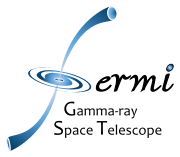 | |||||||
| Names | Gamma-ray Large Area Space Telescope | ||||||
|---|---|---|---|---|---|---|---|
| Mission type | Gamma-ray astronomy | ||||||
| Operator | NASA · U.S. Department of Energy | ||||||
| COSPAR ID | 2008-029A | ||||||
| SATCAT no. | 33053 | ||||||
| Website | Fermi.GSFC.NASA.gov | ||||||
| Mission duration | Planned: 5-10 years Elapsed: 16 years, 5 months, 6 days | ||||||
| Spacecraft properties | |||||||
| Manufacturer | General Dynamics[1] | ||||||
| Launch mass | 4,303 kg (9,487 lb)[1] | ||||||
| Dimensions | Stowed: 2.8 × 2.5 m (9.2 × 8.2 ft)[1] | ||||||
| Power | 1,500 W average[1] | ||||||
| Start of mission | |||||||
| Launch date | 11 June 2008, 16:05 UTC | ||||||
| Rocket | Delta II 7920-H #333 | ||||||
| Launch site | Cape Canaveral SLC-17B | ||||||
| Contractor | United Launch Alliance | ||||||
| Orbital parameters | |||||||
| Reference system | Geocentric | ||||||
| Regime | Low Earth | ||||||
| Semi-major axis | 6,912.9 km (4,295.5 mi) | ||||||
| Eccentricity | 0.001282 | ||||||
| Perigee altitude | 525.9 km (326.8 mi) | ||||||
| Apogee altitude | 543.6 km (337.8 mi) | ||||||
| Inclination | 25.58° | ||||||
| Period | 95.33 min | ||||||
| RAAN | 29.29° | ||||||
| Argument of perigee | 131.16° | ||||||
| Mean anomaly | 229.00° | ||||||
| Mean motion | 15.10 rev/day | ||||||
| Velocity | 7.59 km/s (4.72 mi/s) | ||||||
| Epoch | 23 February 2016, 04:46:22 UTC[2] | ||||||
| |||||||

| |||||||
The Fermi Gamma-ray Space Telescope (FGST,[3] also FGRST), formerly called the Gamma-ray Large Area Space Telescope (GLAST), is a space observatory being used to perform gamma-ray astronomy observations from low Earth orbit. Its main instrument is the Large Area Telescope (LAT), with which astronomers mostly intend to perform an all-sky survey studying astrophysical and cosmological phenomena such as active galactic nuclei, pulsars, other high-energy sources and dark matter. Another instrument aboard Fermi, the Gamma-ray Burst Monitor (GBM; formerly GLAST Burst Monitor), is being used to study gamma-ray bursts[4] and solar flares.[5]
Fermi, named for high-energy physics pioneer Enrico Fermi, was launched on 11 June 2008 at 16:05 UTC aboard a Delta II 7920-H rocket. The mission is a joint venture of NASA, the United States Department of Energy, and government agencies in France, Germany, Italy, Japan, and Sweden,[6] becoming the most sensitive gamma-ray telescope on orbit, succeeding INTEGRAL. The project is a recognized CERN experiment (RE7).[7][8]
- ^ a b c d "GLAST Science Writer's Guide" (PDF). NASA. February 2008. Archived from the original (PDF) on 8 November 2016. Retrieved 23 February 2016.
- ^ "Fermi - Orbit". Heavens Above. 23 February 2016. Retrieved 23 February 2016.
- ^ "FGST: Fermi Gamma-ray Space Telescope". Stanford. Archived from the original on 7 December 2022. Retrieved 5 May 2013.
- ^ "NASA's GLAST Burst Monitor Team Hard at Work Fine-Tuning Instrument and Operations". NASA. 28 July 2008.
- ^ "Fermi Solar Flare Observations".
- ^ "An Astro-Particle Physics Partnership Exploring the High Energy Universe - List of funders". SLAC. Retrieved 9 August 2007.
- ^ "Recognized Experiments at CERN". The CERN Scientific Committees. CERN. Archived from the original on 13 June 2019. Retrieved 21 January 2020.
- ^ "RE7/FERMI : The Fermi Gamma-ray Space Telescope". The CERN Experimental Programme. CERN. Retrieved 21 January 2020.